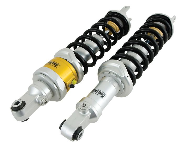 Anti vibration technology is helping to ensure a smooth ride on vehicles ranging from the new Lamborghini Aventador to cars with smaller and lighter fuel-efficient engines
Anti vibration technology is helping to ensure a smooth ride on vehicles ranging from the new Lamborghini Aventador to cars with smaller and lighter fuel-efficient engines
As well as ensuring smooth motion, by managing the physical loads that are transferred from the wheels into the car, shock absorbers can offer even more to a car’s performance, as has recently been seen with the new Lamborghini Aventador.
 The lightweight Aventador features a 6.5 litre V12 engine that gives an effect of 700 horsepower and can achieve 0 to 62mph in 2.9 seconds, with a top speed of 220mph. To guarantee the smooth ride, Öhlins Racing partnered with Trelleborg to develop the shock absorbers, with Trelleborg supplying all sealing components, including O-Rings, Back up Rings, skirted pistons and X-rings. A skirted piston is a continuous polytetrafluoroethylene (PTFE) sleeve, bonded around the shock absorber piston, which acts as a seal and guide.
The lightweight Aventador features a 6.5 litre V12 engine that gives an effect of 700 horsepower and can achieve 0 to 62mph in 2.9 seconds, with a top speed of 220mph. To guarantee the smooth ride, Öhlins Racing partnered with Trelleborg to develop the shock absorbers, with Trelleborg supplying all sealing components, including O-Rings, Back up Rings, skirted pistons and X-rings. A skirted piston is a continuous polytetrafluoroethylene (PTFE) sleeve, bonded around the shock absorber piston, which acts as a seal and guide.
The resulting shock absorbers are said to guarantee an extremely precise, razor-sharp driving performance, even at high speeds.
Rade Catovic, project manager for the Lamborghini damper at Öhlins Racing, commented: “The new Lamborghini Aventador super sports car has a pushrod spring and damper shock-absorbing system inspired by Formula 1. With the help of Trelleborg’s Seals, it was perfectly tuned to meet the needs of a high-performance road vehicle.”
Instead of being located in the wheel mounts, the spring and damper elements are connected inboard to the body or shell structure of the vehicle. The spring and damper elements, or shock absorbers, are transversely positioned – two under the windshield at the front and two close to the engine in the rear. Relay levers and rockers transmit the forces from the wheel mounts to the spring/damper elements. As a result, handling is more responsive and easier to manage at all speeds.
“The Lamborghini Aventador is the only car in series production in the world that has this shock-absorbing solution,” explained Catovic.
Another first is the use of the Ferrari-proven system to lift the front axle. Here, a hydraulic lifting system enables the front end of the car to be lifted 40mm at the touch of a button to avoid minor obstacles when entering garages, driving onto ferry gangplanks or maneuvering over speed bumps. This is also an Öhlins system with Trelleborg seals that are used on the Ferrari 458 and the Ferrari FF.
Reducing vibration
Trelleborg is also helping to ensure that low-energy motoring is as smooth as possible. Large engines such as V12s and V8s run smoothly in terms of vibration, but due to concerns about the environment and rising fuel prices, consumers are turning to smaller, lighter and more fuel-efficient engines. To achieve similar or superior levels of comfort, these new engines require improved vibration-damping technology.
Dual clutch assemblies are helping to provide the smoother automatic gear changes and improved fuel consumption, and in such assemblies the flywheel maintains the crankshaft’s rotational speeds during gear ratio changes, thereby minimising wear and energy loss. However, a circular disc of machined cast steel is a very good sound emitter – and vibration transmitted from the crankshaft can be broadcast as if from a loudspeaker. On top of this, vibration can also wear down associated components such as bearings and mountings.
Trelleborg’s solution takes the form of a damper applied directly to the flywheel to absorb vibration energy transmitted from the crankshaft and pistons. The damper consists of sandwiched layers of rubber and steel that are vulcanized together under pressure to prevent delamination. Its flat ring shape, occupying about a fifth of the flywheel’s surface area, varies in thickness between one and two millimeters.
Clutch-controlled start/stop technology is a further technological advance in this field, minimising fuel use when an engine idles. When the starter motor is operated by depressing the clutch, a toothed wheel engages with teeth on the perimeter of the flywheel and rotates it. Vibration and noise arise both from the action of the restart and during normal running of the engine. Due to experience of vibration damping in drive-trains, Trelleborg has therefore developed suppression technology for a smooth driving experience.
In another area, with automotive designs becoming more lightweight, greater structural vibrations make low-frequency brake noise more pronounced. Trelleborg’s Reqill Tuned Absorbers deal with moans that occur at low speeds and low brake pressure, characterised by a resonant frequency component typically between 100 and 500Hz. They also counteract low-frequency brake squeal in an approximate range of 800–3000Hz. The tuned absorbers are said to have multiple tuning directions, excellent heat resistance and superior durability.
Trelleborg